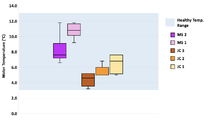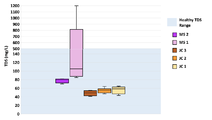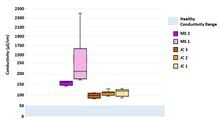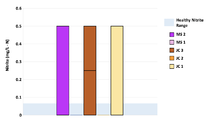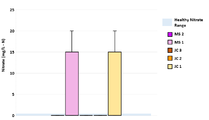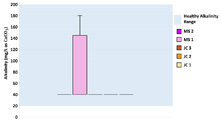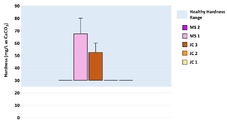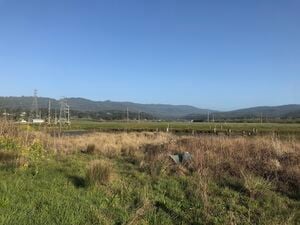
The objective of this project is to assess the water quality health of Martin Slough and Jacoby Creek in Humboldt County for habitat suitability for salmonids.
Abstract[edit | edit source]
Some of the watersheds in Humboldt County have been listed as impared water bodies under the EPA’s 303(d) list for the North Coast Region. For example, Martin Slough was listed in 2006 as an impared spawning habitat due to high levels of sedimentation. Additionally, Jacoby Creek has also been listed as impared and a sediment TMDL is currently being established. On February 13, 2012, both Martin Slough and Jacoby Creek were monitored as part of the Humboldt Baykeeper’s Citizen Water Monitoring Program. Based on the data collected by Humboldt Baykeeper, the turbidity ranged from 91.17 - 224.33 NTUs in Martin Slough and from 160.33 - 209.67 NTUs in Jacoby Creek. It has been observed that salmonids can experience trouble feeding at turbidity levels between 10 - 60 NTUs. Young coho salmon and juvenile coho have been observed to avoid waters with turbidity greater than 70 NTUs and greater than 100 NTUs, respectively. The data from Humboldt Baykeeper suggest that in 2012 both Martin Slough and Janes Creek were not suitable for salmonid habitat based on turbidity levels.
There have been some restoration efforts for both Martin Slough and Jacoby Creek. For Martin Slough a 2.3 acres tidal marsh area was created, the main channel was widened and deepened, and off-channel ponds were created. In 2020, after the completion of the enhancement project’s fourth stage, the Redwood Community Action Agency monitored the channel depth, dissolved oxygen (DO), temperature, and salinity. However, turbidity and other key water quality parameters were not measured as part of the enhancement project’s 2020 analysis. For Jacoby Creek, the Jacoby Creek Land Trust (JCLT) has restored the stream channel using riparian easements, levee removal, and salmonid refuges. Additionally, there are currently wetland restoration projects in the planning stages for the lower parts of Jacoby Creek and Humboldt County has announced plans to dredge sediment accumulation along part of lower Jacoby Creek to reduce local flooding.
Since the data collection in 2012, Humboldt Baykeeper hasn’t continuously monitored the water quality health of these. Consequently, because the current conditions of Martin Slough and Jacoby Creek are unknown, this project analyzed eight water quality parameters (pH, temperature, TDS, conductivity, nitrate, nitrite, alkalinity, and hardness) over four consecutive weeks from 3/6/21 through 3/28/21. Given the current conditions due to the pandemic, there was no access to laboratory-grade instruments; therefore the parameters analyzed were limited. The current water quality conditions were compared to the data collected by Humboldt Baykeeper in 2012 in order to assess the change in water quality health over the last thirteen years. The objective of this project is to assess the water quality health of Martin Slough and Jacoby Creek in Humboldt County for habitat suitability for salmonids.
Location of Jacoby Creek and Martin Slough in Humboldt County[edit | edit source]
-
Figure 1: Map showing both watersheds that were analyzed in this study, Martin Slough and Jacoby Creek, and their relation to one another (ArcMap 2021, StreamStats 2021).
-
Figure 2: Map of Jacoby Creek watershed with the three sampling locations on the main channel denoted as JC 1, JC 2, and JC 3 (ArcMap 2021, StreamStats 2021).
-
Figure 3: Martin Slough watershed with the two sampling locations on the main channel denoted as MS 1 and MS 2 (ArcMap 2021, StreamStats 2021).
Sampling Site Photos[edit | edit source]
Figure 4-7: Photos from the Jacoby Creek sampling sites. 1) Overview of part of the creek watershed. 2) Sampling site JC 1. 3) Sampling site JC 2. 4) Sampling site JC 3.
Figure 8-11: Photos from the Martin Slough sampling site. 1) Eureka Municipal Golf Course through which Martin Slough runs. 2) Enhancement project sign found at the golf course. 3) Sampling site MS 1. 4) Sampling site MS 2.
Methodology: Instruments[edit | edit source]
| Instrument Name | Manufacturer Name & Number | Parameter Name, Range, Accuracy |
| pH Meter | MYBESTFURN, B08865YGW9 | pH, 0.00-14.00, 士 0.01 pH at 25°C |
| Portable E-1 TDS & EC Meter | MYBESTFURN, B08865YGW9 | Total Dissolved Solids, 0-9999 mg/L, 士 2% |
| Conductivity, 0-9999 u/cm, 士 2% | ||
| Insta-Test 5-Way Strips | LaMotte, 3038-G | Nitrite, 0, 0.5, 1, 3, 5, 10 mg/L NO₂ - N |
| Nitrate, 0, 20, 40, 80, 160, 200 mg/L NO₃ - N | ||
| pH, 6.0, 6.5, 7.0, 7.5, 8.0, 8.5, 9.0 | ||
| Alkalinity, 0, 40, 80, 120, 180, 240 mg/L - CaCO₃ | ||
| Hardness, 0, 30, 60, 120, 180 mg/L - CaCO₃ |
Healthy Water Quality Ranges for Salmonids[edit | edit source]
Table 2: The eight parameters measured at each of the sampling sites, and their healthy ranges for salmonids.
| Parameter | Healthy Range | Effects on Salmonids | References |
| pH | 6.5-8.5 | Impaired reproduction, toxicity of pollutants and aquatic insect survival and emergance | Kidd 2011 |
| Temperature | 3.3℃ - 13.3℃ (chinook spring) | Impaired migration, stress, and death. | Carter 2008, Kidd 2011 |
| Total Dissolved Solids | 0 - 500 mg/L | Impaired embryo survival | Carter 2008 |
| Conductivity | < 50 μS/cm | See Total Dissolved Solids | Hansen et al. 1998 |
| Nitrite | < 0.06 mg/L - N | Mortality of Chinook Salmon | EPA 1976 |
| Nitrate | < 0.45 mg/L - N | Eutrophication and decreased DO in water body | Kidd 2011 |
| Alkalinity | > 20 mg/L as CaCO₃ | Reduction of heavy metal toxicity (lower limit) | EPA 1976 |
| Hardness | 25 - 520 mg/L as CaCO₃ | The harder the water, the lower the toxicity of other metals (lead, cadmium, chromium and zinc) to aquatic life. However if it becomes too high it can cause mortality. This maximum value is the limit that causes mortalilty of Atlantic Salmon. | Hansen et al. 1998 and Abernathy 2004. |
Previous Data from the Humboldt Baykeepers[edit | edit source]
Table 3: The previous data for the water quality for each sampling site, provided by the Humboldt Baykeepers.
| Date | Closest Project Sampling Site | Location | pH | Conductivity (μS/cm) | Turbidity Average (NTU) | Hardness (ppm) | Nitrate (mg/L as Nitrogen) |
| 2/13/12 | MC 2 | Martin's Slough @ Campton x Fern | 6.72 | 88.2 | 91 | 50 | 0.13 |
| 2/13/12 | MC 1 | Martins Slough @ Fairway (F St.) | 6.84 | 89.5 | 224 | 50 | 0.51 |
| 2/13/12 | JC 1 | Jacoby Cr @ Old Arcata Rd | 7.18 | 70.1 | 210 | 25 | 0.73 |
| 2/13/12 | JC 2 | Jacoby Creek @ Brookwood | 7.30 | 68.2 | 161 | 25 | 0.71 |
| 2/13/12 | JC 3 | Jacoby Creek @ S. Quarry Rd. | 7.24 | 65.0 | 160 | 25 | 0.70 |
Water Quality Results from Martin Slough and Jacoby Creek[edit | edit source]
-
Figure 12: Box and whisker plot for pH measured at all five sites at Jacoby Creek and Martin Slough (n=12). The healthy range for pH for salmonids is 6.5 - 8.5 (Kidd 2011).]]
-
Figure 13: Box and whisker plot for temperature measured at all five sites at Jacoby Creek and Martin Slough (n=12). The healthy range for temperature for salmonids is 8.3 - 13.3℃ (Carter 2008).
-
Figure 14: Box and whisker plot for total dissolved solids (TDS) measured at all five sites at Jacoby Creek and Martin Slough (n=12). The healthy range for TDS for salmonids is 0 - 500 mg/L (Carter 2008).
-
Figure 15: Box and whisker plot for conductivity measured at all five sites at Jacoby Creek and Martin Slough (n=12). The healthy range for conductivity for salmonids is < 50 μS/cm (Hanson et al. 1998).
-
Figure 16: Box and whisker plot for nitrite measured at all five sites at Jacoby Creek and Martin Slough (n=12). The healthy range for nitrite for salmonids is < 0.06 mg/L - N (EPA 1976).
-
Figure 17: Box and whisker plot for nitrate measured at all five sites at Jacoby Creek and Martin Slough (n=12). The healthy range for nitrate for salmonids is < 0.45 mg/L - N (Kidd 2011).
-
Figure 18: Box and whisker plot for alkalinity measured at all five sites at Jacoby Creek and Martin Slough (n=12). The healthy range for alkalinity for salmonids is > 20 mg/L as CaCO3 (EPA 1976).
-
Figure 19: Box and whisker plot for hardness measured at all five sites at Jacoby Creek and Martin Slough (n=12). The healthy range for hardness for salmonids is 25 -520 mg/L as CaCO3 (Hanson et al. 1998 and Abernathy 2004).
Considerations[edit | edit source]
All values for pH, temperature, alkalinity, and hardness were within the healthy ranges for salmonids (6.5-8.5, 3.3-13.3℃, > 20 mg/L as CaCO3, 25-520 mg/L CaCO3, respectively) (Kidd 2011, Carter 2008, EPA 1976, EPA 1976). The median TDS at MS 1 was within the 0-500 mg/L healthy range for salmonids (Carter 2008), but the conductivity at all five sites in both watersheds was outside the <50 μS/cm healthy range for salmonids (Hanson et al. 1998). The nitrate concentration was outside the healthy range at the most downstream sites, JC 1 and MS 1. The data suggests that Martin Slough and Jacoby Creek were not suitable habitats for salmonids because they exceeded healthy requirements for four of the eight parameters analyzed. There was no clear indication of water quality changes compared to the previous data collected by the Humboldt Baykeepers across any of the parameters.
Precipitation[edit | edit source]
Although there was no flow rate data for any of the six sampling sites during the sampling period, the precipitation data collected by the National Oceanographic and Atmospheric Association (NOAA) for both Arcata and Eureka suggests that the water quality was unlikely to have been influenced by the amount of precipitation observed during the sampling period. The precipitation data from Arcata indicated 2.53 inches of rain over the sampling period, with the largest single day rain event measuring 0.90 inches of rain on March 15. The precipitation data from Eureka indicated 2.62 inches of rain over the sampling period, with the largest single day rain event measuring 0.95 inches of rain on March 15. There was no precipitation data recorded in Eureka for the final sampling date, April 3. The highest rain event day in March occurred the day before the first sample was taken, with 1.95 inches of rain in Arcata and 2.07 inches of rain in Eureka on March 6 (NOAA 2021 A).
Healthy Range[edit | edit source]
The healthy ranges used in this analysis are stated in Table 2. These values are not specific to one species of salmonid and were not selected to represent a specific stage in the salmonid lifecycle. There are specific parts of the salmonid lifecycle in which the salmonids reside in freshwater compared to saltwater. For instance, Pacific salmon present in freshwater rivers are either at the end of their lifecycle, swimming upstream to spawn and die, or developing as newly-hatched juveniles before returning to the sea (USGS 2021). Unlike Pacific salmon, trout (another species of salmonids) do not die after they spawn, which means they could be present in freshwater rivers at any stage of their lifecycle (Wild Trout Trust 2021). Due to the variety of potential salmonid inhabitants at the sampling sites, the healthy range values used in this analysis does not encompass ranges for all types of salmonids, nor for all stages of their life cycles.
Martin Slough Tidal Influence[edit | edit source]
Martin Slough can be affected by the tidal conditions of Humboldt Bay. From the tidal conditions listed in Table 4 for each sample taken at the two sites of Martin Slough, all but two samples were taken near low tide and the other two samples were taken as the tide transitioned from high to low. Because Martin Slough is in a tidal region, the tides could have affected the concentration of TDS and conductivity of Martin Slough, specifically at Sampling Site 1 which is approximately one mile away from Humboldt Bay and at approximately 18 feet of elevation, as compared to Sampling Site 2 which is approximately two and a half miles away from Humboldt Bay and at an elevation of 36 feet.

References[edit | edit source]
- Abernathy, M. A. (2004). “Effect of Water Hardness on the Survival of Rainbow Sharkminnow (Epalzeorhynchos frenatum) Eggs and Larvae.” U of F Masters Thesis.
- California State Water Resources Control Board. (2021). “North Coast Regional Water Quality Control Board.” Euerka Plain | California Northcoast Regional Water Quality Control Board, <https://www.waterboards.ca.gov/northcoast/water_issues/programs/ watershed_info/eureka_plain/> (Apr. 10, 2021).
- Carter, K. (2008). “Effects of Temperature, Dissolved Oxygen/Total Dissolved Gas, Ammonia, and pH on Salmonids.” North Coast Regional Water Quality Control Board.
- EPA. (1976). Quality Criteria for Water. <https://www.epa.gov/sites/production/files/2018-10/documents/quality-criteria-water-1976.pdf> (Mar. 14, 2021).
- Hansen, J. A., Marr, J. C. A., Lipton, J., Cacela, D., and Bergman, H. L. (1998). “Differences in Neurobehavioral Responses of Chinook Salmon (Oncorhynchus Tshawytscha) and Rainbow Trout (Oncorhynchus Mykiss) Exposed to Copper and Cobalt: Behavioral Avoidance.” Environmental Toxicology and Chemistry, 19(9).
- Kalt, J. (2021). “Humboldt Baykeeper's Citizen Monitoring Program Seeks Solutions to Improve Water Quality.” Humboldt Baykeeper, <https://www.humboldtbaykeeper.org/programs/water-quality> (Apr. 11, 2021).
- Kidd, S. (2011). "Summary of standard parameter ranges for salmonid habitat and general stream water quality." Water Quality Monitoring Grant Report, Oregon Watershed Enhancement Board, Salem, Oregon.
- National Oceanographic and Atmospheric Association A (NOAA A). (2021). "Daily Summaries Location Details." <https://www.ncdc.noaa.gov/cdo-web/datasets/GHCND/locations/FIPS:06023/detail> (May 14, 2021).
- National Oceanographic and Atmospheric Association B (NOAA B). (2021). "Tide Predictions at 9418757, Elk River Railroad Bridge CA." <https://tidesandcurrents.noaa.gov/noaatidepredictions.html?id=9418757> (May 14, 2021).
- Natural Resources Services (2021). Martin Slough Enhancement Project, <http://www.naturalresourcesservices.org/projects/martin-slough-enhancement-project> (Mar. 12, 2021).
- USGS (2021). Why do salmon change color and die after they spawn?, <https://www.usgs.gov/faqs/why-do-salmon-change-color-and-die-after-they-spawn?qt-news_science_products=0#qt-news_science_products> (May 14, 2021).
- Wild Trout Trust (2021). “Trout Lifecycle”, <https://www.wildtrout.org/content/trout-lifecycle> (May 14, 2021).
Last updated: 05/25/2021
Originally published: 04/12/2021
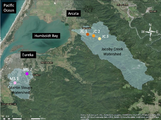





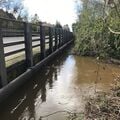




![Figure 12: Box and whisker plot for pH measured at all five sites at Jacoby Creek and Martin Slough (n=12). The healthy range for pH for salmonids is 6.5 - 8.5 (Kidd 2011).]]](/w/images/thumb/d/d6/Assessment_of_the_Water_Quality_Health_Fig_12.png/212px-Assessment_of_the_Water_Quality_Health_Fig_12.png)
